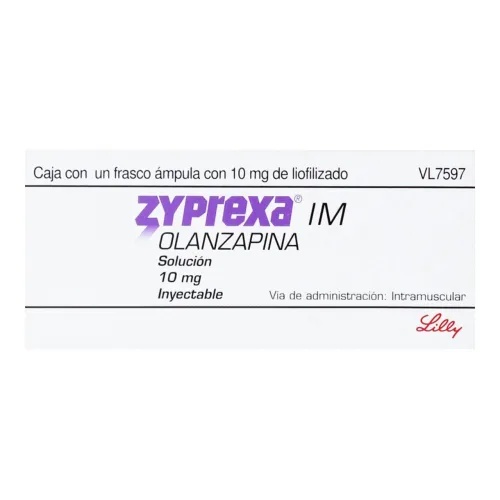

ЗИПРЕКСА 10 мг ПОРОШОК ДЛЯ ПРИГОТОВЛЕНИЯ ИНЪЕКЦИОННОГО РАСТВОРА

Спросите врача о рецепте на ЗИПРЕКСА 10 мг ПОРОШОК ДЛЯ ПРИГОТОВЛЕНИЯ ИНЪЕКЦИОННОГО РАСТВОРА

Инструкция по применению ЗИПРЕКСА 10 мг ПОРОШОК ДЛЯ ПРИГОТОВЛЕНИЯ ИНЪЕКЦИОННОГО РАСТВОРА
Введение
Инструкция: информация для пользователя
ЗYPREXA 10 мг порошок для инъекционной раствора
Оланзапин
Прочитайте внимательно всю инструкцию перед началом использования этого лекарства, поскольку она содержит важную информацию для вас.
- Сохраните эту инструкцию, поскольку вам может потребоваться перечитать ее.
- Если у вас есть какие-либо вопросы, проконсультируйтесь с вашим врачом.
- Если вы испытываете побочные эффекты, проконсультируйтесь с вашим врачом или медсестрой, даже если это побочные эффекты, которые не указаны в этой инструкции. См. раздел 4.
Содержание инструкции
- Что такое ЗYPREXA и для чего она используется.
- Что вам нужно знать перед началом использования ЗYPREXA.
- Как использовать ЗYPREXA.
- Возможные побочные эффекты.
- Хранение ЗYPREXA.
- Содержание упаковки и дополнительная информация.
1. Что такое ЗYPREXA и для чего она используется
ЗYPREXA содержит активное вещество оланзапин. ЗYPREXA инъекционная относится к группе лекарств, называемых антипсихотиками, и показана для лечения симптомов агитации и беспокойства, которые могут возникать при следующих заболеваниях:
- Шизофрения, заболевание, симптомы которого включают слышание, видение или ощущение несуществующих вещей, ошибочные убеждения, необычная подозрительность, и становление замкнутым. Люди, страдающие этими заболеваниями, также могут испытывать депрессию, тревогу или напряжение.
- Маниакальное расстройство, заболевание, симптомы которого включают возбуждение или эйфорию.
ЗYPREXA инъекционная используется, когда необходимо быстрое контролирование агитации и беспокойства, и лечение таблетками ЗYPREXA не является подходящим. Ваш врач перейдет к лечению таблетками ЗYPREXA как можно скорее.
2. Что вам нужно знать перед началом использования ЗYPREXA
Не используйте ЗYPREXA:
- Если вы аллергичны к оланзапину или любому другому компоненту этого лекарства (указанному в разделе 6). Аллергическая реакция может проявляться в виде сыпи, зуда, отека лица или губ, или затруднения дыхания. Если это произойдет, сообщите об этом вашему врачу.
- Если ранее у вас были диагностированы проблемы с глазами, такие как определенные типы глаукомы (повышение давления в глазу).
Предостережения и меры предосторожности
Проконсультируйтесь с вашим врачом или медсестрой перед получением ЗYPREXA инъекционной.
- Сообщите вашему врачу или медсестре, если вы испытываете головокружение или обморок после инъекции. Возможно, вам потребуется лежать до тех пор, пока вы не почувствуете себя лучше. Кроме того, ваш врач или медсестра могут захотеть измерить ваше кровяное давление и пульс.
- Не рекомендуется использование ЗYPREXA у пациентов пожилого возраста с деменцией (смешением или потерей памяти), поскольку это может иметь серьезные побочные эффекты.
- Лекарства этого типа могут вызывать необычные движения, особенно на лице или языке. Если это произойдет после получения ЗYPREXA, сообщите об этом вашему врачу.
- В очень редких случаях лекарства этого типа могут вызывать комплекс симптомов, таких как лихорадка, учащенное дыхание, потоотделение, мышечная жесткость и состояние онемения или сонливости. Если это произойдет, свяжитесь с вашим врачом немедленно. Вам не будут вводить больше инъекций.
- Было обнаружено увеличение веса у пациентов, принимающих ЗYPREXA. Вы и ваш врач должны проверять ваш вес регулярно. Если необходимо, ваш врач может помочь вам спланировать диету или рассмотреть возможность направления к диетологу.
- Были обнаружены повышенные уровни сахара и жиров (триглицеридов и холестерина) в крови у пациентов, принимающих ЗYPREXA. Ваш врач должен проводить анализ крови для контроля уровня сахара в крови и жиров до начала лечения ЗYPREXA и регулярно во время лечения.
- Проконсультируйтесь с вашим врачом, если у вас или у членов вашей семьи есть истории тромбозов, поскольку лекарства этого типа были связаны с образованием тромбов в крови.
Если вы страдаете любым из следующих заболеваний, сообщите об этом вашему врачу как можно скорее:
- Инсульт или временная недостаточность кровотока в мозге (преходящие симптомы инсульта)
- Болезнь Паркинсона
- Проблемы с предстательной железой
- Закупорка кишечника (паралитический илеус)
- Заболевания печени или почек
- Нарушения крови
- Если вы недавно перенесли сердечный приступ или имеете сердечное заболевание, включая синдром больного синусного узла, нестабильную стенокардию или низкое кровяное давление.
- Сахарный диабет
- Судороги
- Если вы считаете, что можете иметь потерю солей в результате длительной диареи и рвоты или использования диуретиков (мочегонных таблеток)
Если вы страдаете деменцией, вы или ваш опекун или член семьи должны сообщить об этом вашему врачу, если у вас когда-либо был инсульт или недостаточность кровотока в мозге.
Как меру предосторожности, если вам более 65 лет, ваш врач должен контролировать ваше кровяное давление.
Дети и подростки
Пациенты моложе 18 лет не должны принимать ЗYPREXA.
Другие лекарства и ЗYPREXA
Возможно, вы будете чувствовать сонливость, если сочетаете ЗYPREXA с любым из следующих лекарств: лекарствами, которые борются с тревогой или помогают заснуть (транквилизаторами, включая бензодиазепины), и антидепрессантами. Используйте другие лекарства одновременно с ЗYPREXA только если ваш врач разрешит это.
Если вы получаете ЗYPREXA инъекционную, не рекомендуется введение бензодиазепинов одновременно, поскольку это может привести к чрезмерной сонливости, может иметь серьезные последствия для вашего сердечного ритма или дыхания и в очень редких случаях может вызвать смерть. Если ваш врач должен ввести вам бензодиазепин для лечения вашего заболевания, он должен сделать это не менее чем через час после введения ЗYPREXA и должен внимательно следить за вами после введения бензодиазепина.
Сообщите вашему врачу, если вы принимаете, недавно принимали или можете принять любое другое лекарство, включая лекарства, приобретенные без рецепта. Особенно сообщите вашему врачу, если вы используете лекарства для болезни Паркинсона.
Использование ЗYPREXA с алкоголем
Не следует пить алкоголь, если вам введена ЗYPREXA, поскольку сочетание с алкоголем может вызвать сонливость.
Беременность и лактация
Если вы беременны или кормите грудью, считаете, что можете быть беременной или планируете стать беременной, проконсультируйтесь с вашим врачом перед использованием этого лекарства. Это лекарство не должно быть введено, если вы кормите грудью, поскольку небольшие количества ЗYPREXA могут попасть в грудное молоко.
Могут возникнуть следующие симптомы у новорожденных детей матерей, лечившихся ЗYPREXA в последнем триместре беременности (последние три месяца беременности): дрожь, мышечная жесткость и/или слабость, сонливость, агитация, проблемы с дыханием и трудности с кормлением. Если ваш ребенок развивает любой из этих симптомов, свяжитесь с вашим врачом.
Вождение и использование машин
Может возникнуть сонливость, когда вам вводят ЗYPREXA. Если это произойдет, не управляйте транспортными средствами и не используйте машины и свяжитесь с вашим врачом.
3. Как использовать ЗYPREXA
В конце этой инструкции, на странице, которую можно отделить от нее, предоставлена информация о реconstitution и методе введения.
Ваш врач решит, какое количество ЗYPREXA вам нужно и на какой срок. Обычно доза составляет 10 мг для первой инъекции, но может быть меньше. Вам могут ввести до 20 мг в течение 24 часов. Доза для пациентов старше 65 лет составляет 2,5 мг или 5 мг.
ЗYPREXA выпускается в виде порошка. Ваш врач или медицинский персонал подготовит с ним раствор и введет вам в мышцу необходимое количество раствора. Инъекция ЗYPREXA предназначена для внутримышечного введения.
Если вы получите больше ЗYPREXA, чем должно быть
Пациенты, получившие больше ЗYPREXA, чем должно быть, испытывали следующие симптомы: учащенное сердцебиение, агитация/агрессивность, проблемы с речью, необычные движения (особенно на лице и языке) и снижение уровня сознания. Другие симптомы могут включать: острую конфузию, судороги (эпилепсию), кому, комбинацию лихорадки, учащенного дыхания, потоотделения, мышечной жесткости, сонливости или летаргии, замедления частоты дыхания, аспирации, повышения или снижения кровяного давления, аномальных сердечных ритмов. Обсудите это с вашим врачом или медицинским персоналом.
Требуются только несколько инъекций ЗYPREXA. Ваш врач решит, когда вам нужно получать ЗYPREXA инъекционную.
Если у вас есть какие-либо другие вопросы о использовании этого лекарства, проконсультируйтесь с вашим врачом или медсестрой.
4. Возможные побочные эффекты
Как и все лекарства, это лекарство может вызывать побочные эффекты, хотя не все люди испытывают их.
Свяжитесь с вашим врачом немедленно, если у вас:
- необычные движения (частый побочный эффект, который может возникнуть у до 1 из 10 человек), особенно на лице или языке.
- тромбы в венах (редкий побочный эффект, который может возникнуть у до 1 из 100 человек), особенно в ногах (симптомы включают отек, боль и покраснение в ноге), которые могут распространиться через кровь в легкие, вызывая боль в груди и трудности с дыханием. Если вы испытываете любой из этих симптомов, немедленно обратитесь к врачу.
- комбинация лихорадки, учащенного дыхания, потоотделения, мышечной жесткости и состояния онемения или сонливости (частота не может быть оценена на основе доступных данных)
Частые побочные эффекты (которые могут возникнуть у до 1 из 10 человек) с ЗYPREXA инъекционной включают более быстрый или более медленный пульс, сонливость, снижение кровяного давления, дискомфорт в месте инъекции.
Некоторые люди испытывают головокружение или обморок (из-за снижения частоты сердечных сокращений) после инъекции, особенно при вставании из положения лежа или сидя. Это чувство обычно проходит само по себе, но если это не произойдет, сообщите об этом вашему врачу или медсестре как можно скорее.
Редкие побочные эффекты (которые могут возникнуть у до 1 из 100 человек) включают более медленное дыхание и аномальный сердечный ритм, который может быть тяжелым.
Кроме того, при приеме таблеток ЗYPREXA могут возникнуть следующие побочные эффекты.
Другие очень частые побочные эффекты (которые могут возникнуть у более 1 из 10 человек) включают увеличение веса; и повышение уровня пролактина в крови. В начальных стадиях лечения некоторые люди могут испытывать головокружение или обморок (с более медленными сердечными сокращениями), особенно при вставании из положения лежа или сидя. Это чувство обычно проходит само по себе, но если это не произойдет, проконсультируйтесь с вашим врачом.
Другие частые побочные эффекты (которые могут возникнуть у до 1 из 10 человек) включают изменения в уровнях некоторых клеток крови, липидов и временные повышения печеночных ферментов; повышение уровня сахара в крови и моче; повышение уровня мочевой кислоты и креатинфосфокиназы в крови; повышение аппетита; головокружение; агитация; дрожь; необычные движения (дискинезия); запор; сухость во рту; сыпь; потеря силы; чрезмерная усталость; задержка жидкости, вызывающая отек рук, лодыжек или ног; лихорадка; боль в суставах; и сексуальные дисфункции, такие как снижение либидо у мужчин и женщин или эректильная дисфункция у мужчин.
Другие редкие побочные эффекты (которые могут возникнуть у до 1 из 100 человек) включают гиперчувствительность (например, воспаление рта и горла, зуд, сыпь на коже); сахарный диабет или ухудшение сахарного диабета, иногда связанные с кетоацидозом (ацетоном в крови и моче) или комой; судороги, в большинстве случаев связанные с историей судорог (эпилепсией); мышечная жесткость или спазмы (включая движения глаз); синдром беспокойных ног; проблемы с речью; заикание; медленный пульс; чувствительность к солнечному свету; носовые кровотечения; вздутие живота; чрезмерное слюноотделение; потеря памяти или забывчивость; недержание мочи; потеря способности мочиться; выпадение волос; отсутствие или снижение менструаций; и изменения в молочной железе у мужчин и женщин, такие как аномальное производство молока или аномальный рост.
Редкие побочные эффекты (которые могут возникнуть у до 1 из 1000 человек) включают снижение температуры тела; аномальный сердечный ритм, внезапная смерть без видимой причины; воспаление поджелудочной железы, вызывающее сильную боль в животе, лихорадку и дискомфорт; заболевание печени, с появлением желтизны кожи и белых участков глаз; мышечное расстройство, проявляющееся как необъяснимые боли; и длительная или болезненная эрекция.
Очень редкие побочные эффекты включают тяжелые аллергические реакции, такие как реакция на лекарство с эозинофилией и системными симптомами (DRESS по английской аббревиатуре). Первоначально DRESS проявляется симптомами, похожими на грипп, с сыпью на лице, и позже с обширной сыпью, лихорадкой, увеличением лимфатических узлов, повышением печеночных ферментов, обнаруживаемым в анализе крови, и увеличением количества эозинофилов в крови.
Во время лечения оланзапином пациенты пожилого возраста с деменцией могут испытывать инсульт, пневмонию, недержание мочи, падения, чрезмерную усталость, визуальные галлюцинации, повышение температуры тела, покраснение кожи и проблемы с ходьбой. Были зарегистрированы некоторые случаи смерти в этой конкретной группе пациентов.
ЗYPREXA может ухудшать симптомы у пациентов с болезнью Паркинсона.
Сообщение о побочных эффектах
Если вы испытываете любой побочный эффект, проконсультируйтесь с вашим врачом или медсестрой, даже если это возможные побочные эффекты, которые не указаны в этой инструкции. Вы также можете сообщить об этом напрямую через национальную систему уведомления, включенную в приложение V. Сообщая о побочных эффектах, вы можете внести свой вклад в предоставление более полной информации о безопасности этого лекарства.
5. Хранение ЗYPREXA
Храните это лекарство вне поля зрения и досягаемости детей.
Не используйте это лекарство после истечения срока годности, указанного на упаковке.
Не храните при температуре выше 25°C. Храните в оригинальной упаковке для защиты от света.
Используйте раствор ЗYPREXA инъекционной до истечения часа после его реconstitution.
Не замораживайте после реconstitution.
Утилизируйте неиспользованный раствор.
6. Содержание упаковки и дополнительная информация
Состав ЗYPREXA для инъекций
- Активное вещество - оланзапин. Каждый флакон содержит 10 мг активного вещества.
- Другие компоненты - лактоза моногидрат, винная кислота, соляная кислота и гидроксид натрия.
Внешний вид продукта и содержание упаковки
ЗYPREXA выпускается в виде желтого порошка, упакованного в флакон. Один флакон ЗYPREXA содержит 10 мг оланзапина. Ваш врач или медицинский персонал подготовит с его помощью раствор для инъекции.
Порошок ЗYPREXA для приготовления раствора для инъекций выпускается в упаковках по 1 или 10 флаконов. Возможно, что будут продаваться только некоторые размеры упаковок.
Владелец разрешения на маркетинг
CHEPLAPHARM Registration GmbH, Weiler Straße 5e, 79540 Lörrach, Германия.
Производитель
Lilly S.A., Avda. de la Industria 30, 28108 Alcobendas, Madrid, Испания.
Prestige Promotion Verkaufsfoerderung & Werbeservice GmbH, Borsigstrasse 2, 63755 Alzenau, Германия.
CHEPLAPHARM Registration GmbH, Weiler Straße 5e, 79540 Lörrach, Германия
Дата последнего обзора этой инструкции:
Подробная информация о этом лекарстве доступна на сайте Европейского агентства по лекарственным средствам http://www.ema.europa.eu
--------------------------------------------------------------------------------------------------------------------
(Перфорация с информацией, предназначенной для медицинского персонала, которая позволяет отделить ее от основной части инструкции)
ИНСТРУКЦИИ ДЛЯ МЕДИЦИНСКОГО ПЕРСОНАЛА
Переработка и введение ЗYPREXA
Переработайте порошок ЗYPREXA для приготовления раствора для инъекций только с помощью воды для инъекций.
Порошок ЗYPREXA для приготовления раствора для инъекций не должен смешиваться в шприце с любыми лекарствами, доступными на рынке, из-за несовместимости. См. примеры ниже.
Оланзапин для инъекций не должен смешиваться в шприце с галоперидолом для инъекций, поскольку низкий pH, полученный в результате, показал, что оланзапин разлагается со временем.
Оланзапин для инъекций не может быть смешан в шприце или использован вместе с бензодиазепинами.
Порошок для приготовления раствора для инъекций
Порошок ЗYPREXA 10 мг для приготовления раствора для инъекций должен быть переработан с использованием стандартных асептических методов переработки парентеральных продуктов.
1. | Ввести 2,1 мл воды для инъекций в стерильный шприц. Ввести ее в флакон с порошком ЗYPREXA для приготовления раствора для инъекций. | |||
ЗYPREXA. | ||||
2. | Повернуть флакон, пока содержимое не растворится полностью, в результате чего получается раствор желтого цвета. Флакон содержит 11,0 мг оланзапина, что дает раствор с концентрацией 5 мг/мл. Когда используются 2,0 мл раствора, в флаконе и шприце остается остаток 1 мг оланзапина; поэтому извлекается 10 мг оланзапина. | |||
Когда используются 2,0 мл раствора, в флаконе и шприце остается остаток 1 мг оланзапина; поэтому извлекается 10 мг оланзапина. | ||||
3. | В следующей таблице указаны объемы инъекций для различных доз оланзапина: | |||
Доза в мг | Объем инъекции в мл | |||
10 | 2,0 | |||
7,5 | 1,5 | |||
5 | 1,0 | |||
2,5 | 0,5 | |||
4. | Раствор должен вводиться внутримышечно. Не вводить ни внутривенно, ни подкожно. | |||
Не вводить ни внутривенно, ни подкожно. | ||||
5. | Утилизировать шприц и любой остаток раствора ответственно. | |||
6. | Использовать переработанный раствор в течение часа после переработки. Не хранить при температуре выше 25°C. Не замораживать. |
Если раствор и упаковка позволяют, лекарства для парентерального использования должны быть осмотрены перед введением, чтобы проверить, что они не содержат твердых частиц.

Сколько стоит ЗИПРЕКСА 10 мг ПОРОШОК ДЛЯ ПРИГОТОВЛЕНИЯ ИНЪЕКЦИОННОГО РАСТВОРА в Испании в 2025 году?
Средняя цена на ЗИПРЕКСА 10 мг ПОРОШОК ДЛЯ ПРИГОТОВЛЕНИЯ ИНЪЕКЦИОННОГО РАСТВОРА в декабрь, 2025 года составляет около 24.13 евро. Финальная стоимость может зависеть от региона, конкретной аптеки и рецептурного статуса. Для точной информации лучше проверить онлайн или в ближайшей аптеке.
- Страна регистрации
- Средняя цена в аптеках24.13 EUR
- Активное вещество
- Требуется рецептДа
- Производитель
- Информация носит справочный характер и не является медицинской рекомендацией. Перед приемом любых препаратов проконсультируйтесь с врачом. Oladoctor не несет ответственности за медицинские решения, принятые на основе этого контента.
- Аналоги ЗИПРЕКСА 10 мг ПОРОШОК ДЛЯ ПРИГОТОВЛЕНИЯ ИНЪЕКЦИОННОГО РАСТВОРАФорма выпуска: ТАБЛЕТКА, 10 мгАктивное вещество: ОланзапинПроизводитель: Neuraxpharm Spain S.L.Требуется рецептФорма выпуска: ТАБЛЕТКА, 2,5 мгАктивное вещество: ОланзапинПроизводитель: Neuraxpharm Spain S.L.Требуется рецептФорма выпуска: ТАБЛЕТКА, 5 мгАктивное вещество: ОланзапинПроизводитель: Neuraxpharm Spain S.L.Требуется рецепт
Аналоги ЗИПРЕКСА 10 мг ПОРОШОК ДЛЯ ПРИГОТОВЛЕНИЯ ИНЪЕКЦИОННОГО РАСТВОРА в других странах
Лучшие аналоги с тем же действующим веществом и терапевтическим эффектом.
Аналог ЗИПРЕКСА 10 мг ПОРОШОК ДЛЯ ПРИГОТОВЛЕНИЯ ИНЪЕКЦИОННОГО РАСТВОРА в Польша
Аналог ЗИПРЕКСА 10 мг ПОРОШОК ДЛЯ ПРИГОТОВЛЕНИЯ ИНЪЕКЦИОННОГО РАСТВОРА в Украина
Врачи онлайн по ЗИПРЕКСА 10 мг ПОРОШОК ДЛЯ ПРИГОТОВЛЕНИЯ ИНЪЕКЦИОННОГО РАСТВОРА
Консультация по дозировке, побочным эффектам, взаимодействиям, противопоказаниям и продлению рецепта на ЗИПРЕКСА 10 мг ПОРОШОК ДЛЯ ПРИГОТОВЛЕНИЯ ИНЪЕКЦИОННОГО РАСТВОРА – по решению врача и с учетом местных правил.









